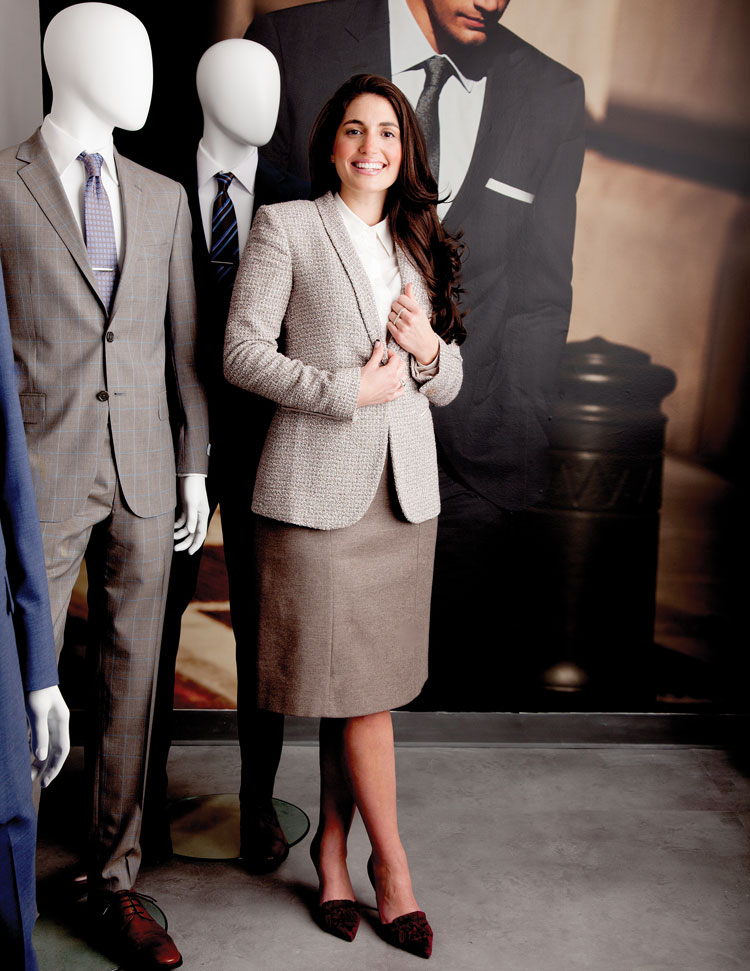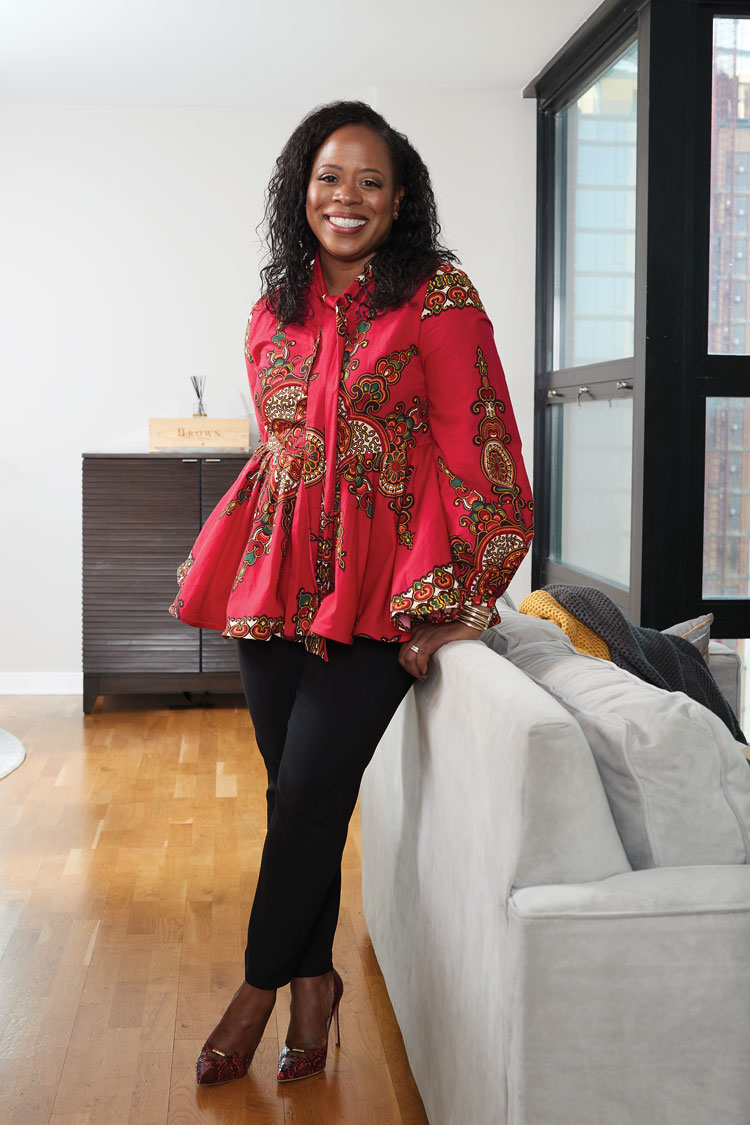Lawyer fashion evolves to reflect personality and tradition

Danielle Schivek: “What an attorney looks like today is totally fluid and changing.” Photo by Len Irish.
Brown admits it can be difficult to find clothes that are easy, stylish and professional. She was an early adopter of MM.LaFleur, an online styling company that helps professional women create their own look—including dresses, blazers and accessories—and sends what they pick out as a complete outfit.
“I’ve shared them with other people. I find it easier than going to stores and chasing styles,” Brown says. “I don’t want to go spend $250 on a pair of slacks and more on a suit coat that I would only wear occasionally. You can wear something that’s a canvas and add a nice necklace, cool shoes and tights. If I’m trying to be lawyer-conservative, I’d rather do that than go entirely old-school.”
Virtual and in-person stylists provide a modern solution for busy legal professionals who might or might not care much about fashion and don’t have time for leisure shopping. MM.LaFleur stylist Shelby Goldfaden says the company’s goal is to “take the work out of dressing for work” by focusing on fashionable but timeless pieces that are machine-washable and wrinkle-resistant. “Most importantly, we want you to look good and not think about your outfit,” Goldfaden says.
The 5-year-old company has been conducting focus groups consisting of female attorneys to find out what they’re wearing in various professional settings and how that changes by region. Goldfaden says she was fascinated by the differences in dress norms.
“A few people said that in certain counties, women had to wear skirts to court and couldn’t wear pants,” she says. “Women in New York said wearing anything cropped made them look less serious. Color was very important in court—stick to neutrals—black, navy, charcoal. Others came in and said, ‘When I’m in the office, I can wear anything.’ ”
WHAT’S OLD IS NEW AGAIN
You can’t wear just anything if you’re taking the bar exam in Virginia. Sure, you’ve got to be mentally prepared, but you also need to be properly dressed.
The Virginia Board of Bar Examiners has a mandatory dress code stating that while law firms may have various “dress down” policies, “there is no ‘dress down’ or ‘casual dress’ policy at the Virginia Bar Exam.” Test takers “are expected to dress in proper attire. For men, proper attire is coat and tie. For women, proper attire is traditional business attire.”
This enforced formality may be welcome for some who are uncomfortable with the shifting concepts of propriety that blur the line. Fashion observers say there is somewhat of a backlash by the younger generation against the casual-dressing trend of recent years, with many millennials harking back to a more button-down style.
Perhaps it’s the cultural exposure to more conservative religious views or ethnic dress, as multiculturalism in America continues to expand. Or it could be the cycle of fashion, where everything old is new again and designers seek fresh trends by reviving old ones.

Tasha Brown: “What I don’t believe is that you have to dress like a man version of something to be professional, a respected lawyer and appropriate.” Photo by Saverio Truglia.
“I do think we’re seeing a lot more coverage,” says Scafidi of the Fashion Law Institute, noting longer sleeves and hemlines on the racks. “What I’m hearing is a little bit more conservatism and a desire to dress more formally from the men. A generation of men in their 20s who don’t feel required to wear suits to work, so they’re starting to embrace tailoring a bit more. More of the sense of the advice to dress for the job you want. Women are aware of the need to look put together and professional at some level but are enjoying the freedom to dress as they want.”
Millennial attorney Danielle Schivek, counsel at Authentic Brands Group in New York City, understands that she has wardrobe options that weren’t available for attorneys even a decade ago.
Schivek is a fan of the sartorial swagger of the lawyers on Suits, particularly the character Jessica Pearson, a firm co-founder and former managing partner who “has never worn the same thing twice in six years,” according to the show’s website.
For Schivek, power-dressing has never appeared more fashionable. Even though Pearson dons a dress instead of a formal suit, “she’s a strong, competent and powerful person,” Schivek says.
“Whatever dress it is—maybe Alexander McQueen and pumps—I don’t see anything wrong with that. Yes, she’s a woman, but she’s strong and influential. She [wears] amazing tops and dresses. But if I ran those outfits by someone from another generation, they would say, ‘No, you need a matching suit.’ ”
As a fan of fashion throughout school and her career, Schivek is an astute observer of current trends. She wrote an article in September for the New York Law Journal, “The Rewritten Rules of Power Dressing,” after she came across an old career-services packet from her school that encouraged women to wear skirt suits and pantyhose to interviews.
“I thought that was funny because I couldn’t remember the last time I wore nude pantyhose, other than when my mother forced me when I was young,” Schivek says.
She remembers the traditional advice given by her parents: Avoid patterns, wear dark colors and stay within the lane. The general sentiment was: “You don’t want to be unique; you have to look like an attorney,” Schivek says. “But what does an attorney look like to you? It might be something different for me.”
But Schivek adds: “Mom is right a lot of the time, so in building my professional wardrobe, I definitely thought I needed a dark suit. But it’s a skirt from Escada, black wool with white wool in there. It has something a little fun for me. I couldn’t bear to do just plain black. Another suit has a tuxedo stripe down the pants leg and on the lapel.”
Schivek acknowledges that what a lawyer should wear depends on the audience, their position and personal taste. For some, clothing is a utilitarian afterthought. For others, it’s an art form.
On certain days, a lawyer’s outfit could be a suit of armor that prepares them mentally and visually for a legal battle. The next day’s look might require a break from the formality.
Schivek describes seeing her firm’s general counsel alternately in jeans, button-downs and a blazer but also dressed in a three-piece suit. “What an attorney looks like today is totally fluid and changing.”
This article was published in the February 2018 ABA Journal magazine with the title "What Suits You? Lawyer fashion evolves to reflect both personality and tradition."



